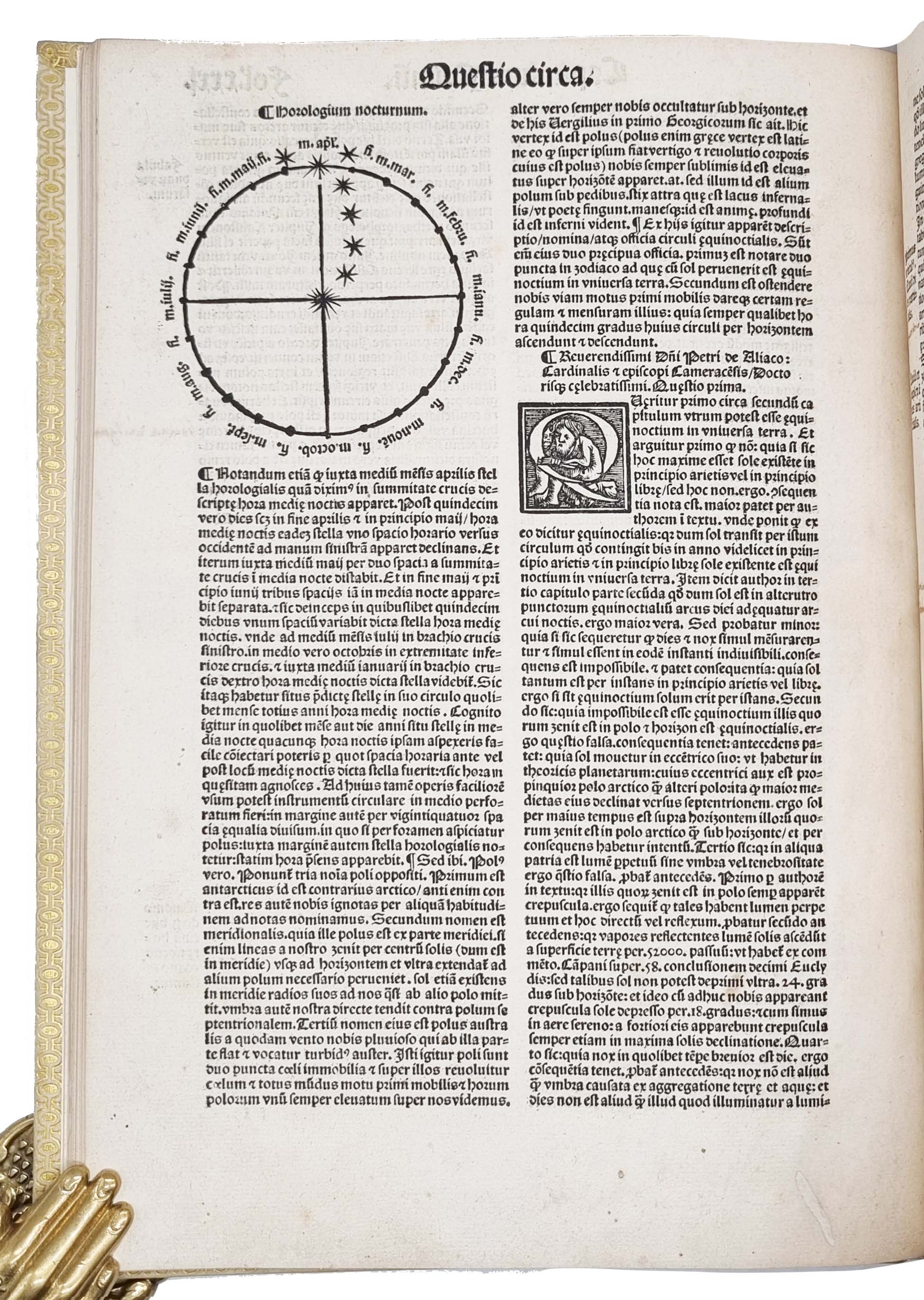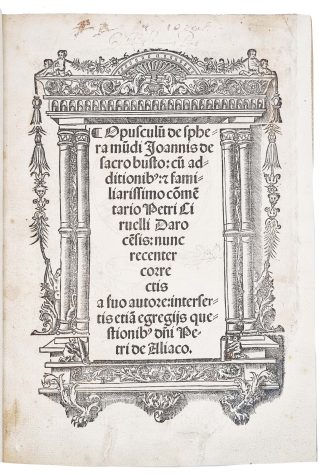DE SACROBOSCO, Johannes.
De Sphaera.
Alcala de Henares, Miguel de Eguia, 1526£5,250.00
Folio. Ff. 73 (i). Gothic and Roman letter, double column. Woodcut architectural border to tp, armillary sphere to verso and last, naturalistic and historiated initials, woodcut astronomical diagrams of spheres and astronomical tables. Bookplate of Peter & Margarethe Braune and Spanish typed book description to pastedown, faded early ex libris to tp of Joannis Plenis. Occasional marginalia. Slight age yellowing, some foxing, repaired worm trails to some lower margins, occasionally just touching text, tp restored at lower and outer margins, also a few lower outer corners. A good clean copy in modern vellum ruled gilt with floral tools at corners, spine gilt.
First edition printed in Spain of this important early modern astronomy textbook, which includes a critique of the then-used Julian calendar as well as a recommended solution remarkably similar to today’s Gregorian calendar. Johannes de Sacrobosco (c. 1195-1256) was a scholar, monk and astronomer who in this publication gives a readable account of the Ptolemaic universe. His Anglicised name is John Hollywood; he was an exceptional early English forerunner in the sciences prior to the likes of Bacon and Newton. Ptolemy’s (updated) Almagest had been translated into Latin in 1175 by Gerard of Cremona from the Arabic translation held in Toledo and copies quickly found their way to Paris.
Sacrobosco’s sphere was the imaginary backdrop of the stars in the sky, which was the meaning of the word ‘world’ at that time, not the earth as we know it. Sacrobosco quotes the Greek astronomer Theodosius when stating it is a solid body. Through principally about the heavens it also contains a clear description of the Earth as a sphere. In fact, the Earth was perceived as a sphere widely during the higher Middle Ages. Sacrobosco’s Sphaera went on to become required reading by students in all Western European universities for the next four centuries.
The text is divided into four chapters. The first discusses the general structure of the universe, and second the circles of the celestial sphere, the third the daily rotation of the heavens and the climates of the Earth, and the fourth planetary movements and eclipses. The universe is divided into nine parts: the “first moved”, the sphere of the fixed stars, and then the seven planets; Saturn, Jupiter, Mars, the sun, Venus, Mercury and the moon. There are two movements of the sphere: one of the heavens from east to west on its axis, and the other of the inferior spheres at 23 degrees in the opposite direction of their own axes. The world is then divided into two parts; the elementary and the ethereal. The elementary is made up of the four elements; earth, water, air and fire. The ethereal is immutable and named the ‘fifth essence’. Sacrobosco calls the universe the machina mundi, machine of the world, likening the movement to clockwork. This analogy became popular during the Enlightenment.
“Pedro Ciruelo was following Lefèvre d’Étaples’s example when he printed his commentary to the Tractatus de sphaera only 3 years after the Parisian professor had published his own in 1495. Ciruelo seems to confirm that this was the case in his own words in the new version of the preface to the Sphaera of Sacrobosco that he prepared for publication in Alcalá de Henares in 1526 (Ciruelo 1526). It has been pointed out that Ciruelo seems to have shared some of the ideas expressed by Lefèvre concerning, for instance, the reality of the celestial orbs (in this case, an idea also held by Pierre d’Ailly) (Barker 2011, 15–16). The extent to which both shared mathematical notions and natural philosophical ideas on the heavens is a subject still waiting to be explored in depth.” (Valleriani, Matteo. De sphaera of Johannes de Sacrobosco in the Early Modern Period, 2020).
16th century Spanish scientific imprints are rare.
Brunet IV 160I; Palau 284125; Cantamessa 6998; Not in Adams, Houzeau and Lancaster or Honeyman.In stock




